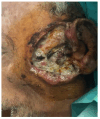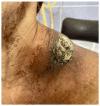Immunosuppression and Outcomes in Patients with Cutaneous Squamous Cell Carcinoma of the Head and Neck
- PMID: 39851804
- PMCID: PMC11764338
- DOI: 10.3390/clinpract15010021
Immunosuppression and Outcomes in Patients with Cutaneous Squamous Cell Carcinoma of the Head and Neck
Abstract
Cutaneous squamous scell carcinoma (cSCC) is a frequent non-melanoma skin cancer that originates from keratinocytes with increased prevalence. cSCC can be either in situ, as in Bowen's disease, or extended. Advanced age, accumulated sun exposure, light pigmentation, and prior skin cancer diagnosis are all significant risk factors for cSCC. Although most cSCCs can be treated surgically, some recur and metastasize, resulting in death. The role of immune status is not yet determined in the prognosis of these patients. Objective. Immunosuppressed patients are more likely to develop cSCC, which is often characterized by more aggressive, multifocal lesions. This study aimed to determine the risks of mortality in patients with cSCC and immunosuppression versus non immunosuppression and to compare variations in overall survival based on different clinical features. Method. We evaluated clinical cases of patients at "Sfantul Apostol Andrei" Emergency Hospital of Galati, Romania, from 1 March 2018 to 1 April 2024. Subjects in the trial had to be at least 18 years old and have a pathologically confirmed diagnosis of cutaneous head and neck squamous cell carcinoma (cHNSCC). We divided the patients into two different categories based on whether they had immunosuppression. Results. In this cohort of 68 subjects with cSCC, patients with immunosuppression had significantly lower overall survival, as well as lower three- and five-year survival rates compared with those without immunosuppression, even after adjustment for age, sex, stage, and previous surgical treatment. The median survival time for immunosuppressed individuals ranged from 11 to 21 months, varying based on their particular characteristics, and most critically, on the presence of other malignancies, while that of immunocompetent patients ranged from 18 to 51 months. In addition, immune-deficient patients with early-stage disease had a 21-month median survival rate that changed to11 months for advanced-stage cases. In a similar manner, immunocompetent patients with early-stage cancer had a significantly better median survival than those withadvancedstages,43 versus 18months. Our results indicate that immunosuppression is a distinct risk factors associated with a less favorable outcome in patients with cHNSCC.
Keywords: cutaneous squamous cell carcinoma; head and neck skin cancer; immunosuppression.
Conflict of interest statement
The authors declare no conflicts of interest.
Figures




Similar articles
-
Age is not a predictor of prognosis in metastatic cutaneous squamous cell carcinoma of the head and neck.ANZ J Surg. 2018 Apr;88(4):E273-E277. doi: 10.1111/ans.13757. Epub 2016 Nov 7. ANZ J Surg. 2018. PMID: 29611361
-
Association of Immunosuppression With Outcomes of Patients With Cutaneous Squamous Cell Carcinoma of the Head and Neck.JAMA Otolaryngol Head Neck Surg. 2020 Feb 1;146(2):128-135. doi: 10.1001/jamaoto.2019.3751. JAMA Otolaryngol Head Neck Surg. 2020. PMID: 31804658 Free PMC article.
-
A multi-institutional comparison of outcomes of immunosuppressed and immunocompetent patients treated with surgery and radiation therapy for cutaneous squamous cell carcinoma of the head and neck.Cancer. 2017 Jun 1;123(11):2054-2060. doi: 10.1002/cncr.30601. Epub 2017 Feb 7. Cancer. 2017. PMID: 28171708
-
Cutaneous Squamous Cell Carcinoma: From Pathophysiology to Novel Therapeutic Approaches.Biomedicines. 2021 Feb 9;9(2):171. doi: 10.3390/biomedicines9020171. Biomedicines. 2021. PMID: 33572373 Free PMC article. Review.
-
Immunosuppression Impact on Head and Neck Cutaneous Squamous Cell Carcinoma: A Systematic Review with Meta-analysis.Otolaryngol Head Neck Surg. 2019 Mar;160(3):439-446. doi: 10.1177/0194599818808511. Epub 2018 Oct 23. Otolaryngol Head Neck Surg. 2019. PMID: 30348055
References
-
- Tokez S., Wakkee M., Kan W., Venables Z.C., Mooyaart A.L., Louwman M., Nijsten T., Hollestein L.M. Cumulative incidence and disease-specific survival of metastatic cutaneous squamous cell carcinoma: A nationwide cancer registry study. J. Am. Acad. Dermatol. 2022;86:331–338. doi: 10.1016/j.jaad.2021.09.067. - DOI - PubMed
-
- Skulsky S.L., O’Sullivan B., McArdle O., Leader M., Roche M., Conlon P.J., O’Neill J.P. Review of high-risk features of cutaneous squamous cell carcinoma and discrepancies between the American Joint Committee on Cancer and NCCN Clinical Practice Guidelines in Oncology. Head Neck. 2017;39:578–594. doi: 10.1002/hed.24580. - DOI - PubMed
-
- Palmer J.D., Schneider C.J., Hockstein N., Hanlon A.L., Silberg J., Strasser J., Mauer E.A., Dzeda M., Witt R., Raben A. Combination of post-operative radiotherapy and cetuximab for high-risk cutaneous squamous cell cancer of the head and neck: A propensity score analysis. Oral Oncol. 2018;78:102–107. doi: 10.1016/j.oraloncology.2018.01.015. - DOI - PubMed
-
- Luk P.P., Ebrahimi A., Veness M.J., McDowell L., Magarey M., Gao K., Palme C.E., Clark J.R., Gupta R. Prognostic value of the 8th edition American Joint Commission Cancer nodal staging system for patients with head and neck cutaneous squamous cell carcinoma: A multi-institutional study. Head Neck. 2021;43:558–567. doi: 10.1002/hed.26512. - DOI - PubMed
LinkOut - more resources
Full Text Sources
Miscellaneous

